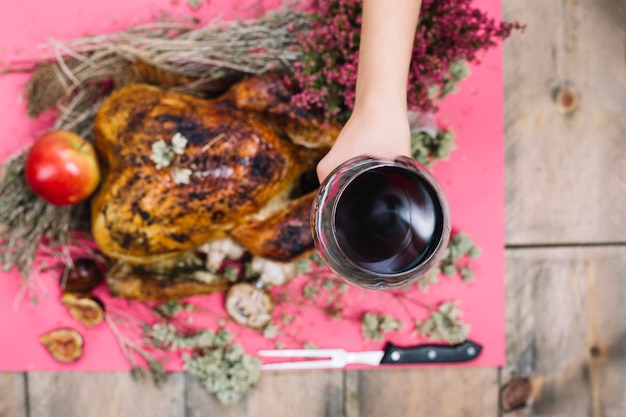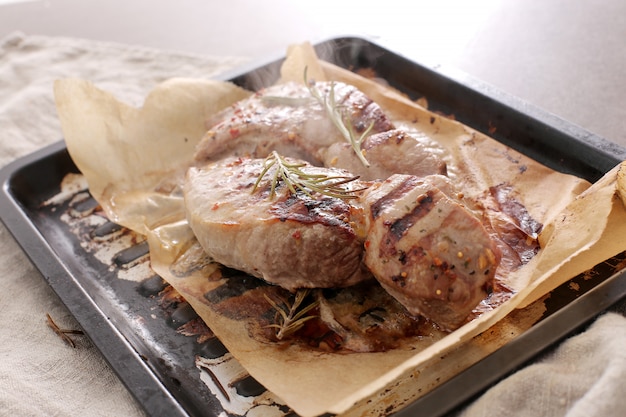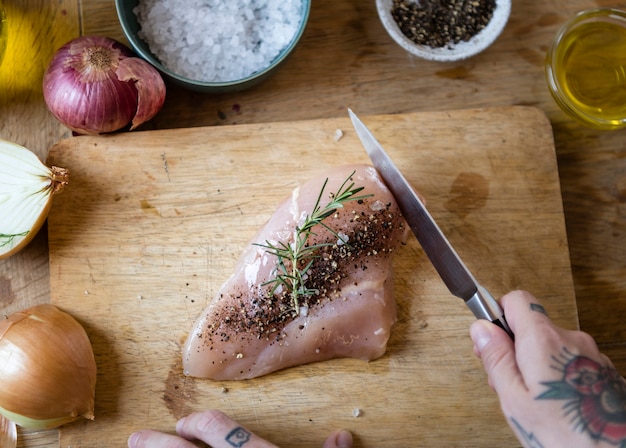Let's be honest, pork tenderloin is a real crowd-pleaser. It's tender, juicy, and oh so versatile. It's a staple in our house, and I bet it's a favourite in yours too. But, getting it cooked just right can be a bit of a puzzle. You want to avoid that dry, overcooked nightmare, and instead, achieve that perfect pink, succulent centre.
Well, fear not, my culinary comrades! I'm here to guide you through the wonderful world of pork tenderloin cooking times. We'll be exploring the different ways to cook it, from oven to grill, and everything in between. We'll delve into the science behind those perfect pink hues, and I'll share some of my tried and tested tips and tricks to make sure your next pork tenderloin is an absolute triumph.
Ready to unleash your inner culinary genius? Let's get cooking!
(Part 1) The Basics: Understanding the Pork Tenderloin

First things first, let's get to know our star ingredient. Pork tenderloin, for those who haven't met, is a long, lean cut of meat that comes from the loin of the pig. It's relatively small, which makes it ideal for smaller gatherings or if you're just after a quick and easy meal.
Now, here's the thing about pork tenderloin: it's very lean, which means it can dry out easily if you're not careful. This is why it's so important to cook it to the right temperature and for the right amount of time.
Why Temperature Matters More Than Time
The key to a juicy pork tenderloin is all about internal temperature. Unlike other meats, we're not aiming for a set time on the stove or in the oven. Instead, we're looking for a specific temperature reading in the centre of the meat.
The Food Standards Agency recommends cooking pork to an internal temperature of 71°C (160°F) to ensure it's safe to eat. This ensures that any bacteria lurking within the meat is safely killed off.
But, let's be honest, nobody wants dry, tough pork, right? That's why many chefs and home cooks recommend aiming for a slightly lower internal temperature of 63°C (145°F). At this temperature, the meat is still safe to eat, but it's much more likely to remain juicy and tender.
Think of it this way: the longer you cook the pork, the more moisture it loses. Aiming for a slightly lower internal temperature allows the meat to reach a safe level while retaining its natural juiciness.
The Resting Ritual: A Must-Do
Once your pork tenderloin has reached its desired internal temperature, it's important to let it rest for a few minutes before slicing into it. This allows the juices to redistribute throughout the meat, ensuring that your final product is beautifully tender and succulent.
Think of it as a little spa day for your pork. Give it a few minutes to relax and rehydrate itself. It's a crucial step in achieving that melt-in-your-mouth texture.
As a general rule of thumb, allow your pork tenderloin to rest for 5-10 minutes before carving.
(Part 2) Cooking Methods: Oven, Grill, or Pan-Seared?

Alright, so you've got your pork tenderloin ready to go. Now, you need to decide how you're going to cook it. There are plenty of options out there, and the choice really comes down to personal preference and what equipment you have available.
Oven-roasted pork tenderloin: The Classic Choice
For a classic, fuss-free approach, oven-roasting is the way to go. It's super simple and really lets the natural flavours of the pork shine through.
Here's the basic process:
1. Preheat your oven to 190°C (375°F). Make sure your oven is nice and hot before you put the pork in. It'll create a nice crispy crust on the outside while keeping the inside moist.
2. Season your tenderloin with salt, pepper, and any other herbs or spices you like. I'm a big fan of rosemary and thyme, but you can go wild with your flavour combinations! Think about what kind of flavour profile you're aiming for - a Mediterranean twist, a smoky barbecue vibe, or something earthy and herbaceous.
3. Place the tenderloin on a baking sheet lined with parchment paper or foil. This will make cleaning up a breeze. Plus, the parchment paper will prevent the tenderloin from sticking to the pan.
4. Roast the tenderloin for 20-25 minutes, or until it reaches an internal temperature of 63°C (145°F). The actual time will depend on the size of your tenderloin, so keep an eye on it.
5. Let the tenderloin rest for 5-10 minutes before carving.
Grill-Grilled Pork Tenderloin: Smoky Goodness
If you're feeling adventurous and want to add a little smoky flavour, grilling is a fantastic option.
Here's how to grill a perfect pork tenderloin:
1. Preheat your grill to medium-high heat. You want the grill nice and hot, but not blazing! You'll need that heat to get those beautiful grill marks.
2. Season your tenderloin with salt, pepper, and any other spices you like. Remember, the grill will give it that smoky flavour, so keep your seasoning relatively simple.
3. Place the tenderloin on the grill and cook for about 5-7 minutes per side. You want to get nice grill marks without burning the meat. Make sure to rotate the tenderloin 90 degrees halfway through to ensure even cooking.
4. Reduce the heat to medium and cook for another 10-15 minutes, or until the internal temperature reaches 63°C (145°F).
5. Remove the tenderloin from the grill and let it rest for 5-10 minutes before carving.
Pan-Seared Pork Tenderloin: A Quick and Easy Meal
Sometimes, you just want a quick and easy meal, and pan-searing is the perfect solution. It's a great way to achieve a crispy crust while keeping the inside nice and juicy.
Here's the rundown:
1. Heat a large skillet or frying pan over medium-high heat. Get that pan really hot! You want the oil to shimmer before you add the pork.
2. Season your tenderloin with salt, pepper, and any other spices you like.
3. Add a tablespoon or two of oil to the pan and heat until it shimmers.
4. Carefully place the tenderloin in the hot pan and cook for 3-4 minutes per side. You want to get a nice golden-brown crust. Be careful, as the hot oil will splatter.
5. Reduce the heat to medium and cook for another 5-7 minutes, or until the internal temperature reaches 63°C (145°F).
6. Remove the tenderloin from the pan and let it rest for 5-10 minutes before carving.
(Part 3) Cooking Times: A Detailed Guide

Alright, so we've covered the basics of pork tenderloin cooking, but what about those actual times? Let's dive into a more detailed guide for different sizes of pork tenderloin:
Pork Tenderloin Cooking Times Chart
Here's a handy chart outlining the approximate cooking times for different sizes of pork tenderloin:
| Size of Pork Tenderloin (in pounds) | Approximate Cooking Time (in minutes) |
|---|---|
| 1 lb | 20-25 minutes |
| 1.5 lb | 25-30 minutes |
| 2 lb | 30-35 minutes |
Note: These times are just estimates and may vary depending on your oven or grill temperature, the thickness of your tenderloin, and other factors. The best way to ensure your pork is cooked perfectly is to use a meat thermometer.
(Part 4) Pork tenderloin tips and Tricks
Now, here's where things get really fun. Let's sprinkle in some extra tips and tricks to elevate your pork tenderloin game:
1. Brine It For Extra Juiciness
If you really want to take your pork tenderloin to the next level, try brining it before cooking. Brining involves soaking the meat in a salt solution, which helps to retain moisture and add flavour.
To brine your pork tenderloin, simply combine 1 cup of salt with 8 cups of water. Submerge the tenderloin in the brine and refrigerate for at least 4 hours, or up to 24 hours. The longer you brine it, the more tender and flavorful it will be.
2. Don’t Overcrowd the Pan
When cooking your pork tenderloin, don't overcrowd the pan or baking sheet. This will make the meat steam instead of browning, leading to a less appealing result. If you have a large tenderloin, consider cooking it in two batches. You want to give each piece of meat enough space to cook evenly and develop a nice crust.
3. Use a Meat Thermometer!
As I mentioned before, the best way to ensure your pork tenderloin is cooked to perfection is to use a meat thermometer. This will help you avoid overcooking, which can lead to dry and tough meat. A meat thermometer is a simple, affordable tool that will take the guesswork out of cooking pork.
4. Let It Rest, Let It Rest!
Once your pork tenderloin is cooked, let it rest for at least 5-10 minutes before carving. This allows the juices to redistribute throughout the meat, resulting in a more tender and flavorful final product. Think of it as a little reward for your hard work - the tenderloin will thank you for it!
5. Experiment with Flavour
Pork tenderloin is a blank canvas for flavour. Don't be afraid to experiment with different herbs, spices, and marinades. You can even create a simple glaze to add a touch of sweetness and shine. Get creative! Try infusing your tenderloin with citrus zest, rosemary, garlic, or even a touch of chili flakes.
(Part 5) Pork tenderloin recipes: Time to Get Creative!
Right, let's put those cooking skills into practice. Here are a few of my favourite pork tenderloin recipes to get you inspired:
1. Garlic and Herb Roasted Pork Tenderloin
This is a classic for a reason. It's simple, flavourful, and always a crowd-pleaser.
Ingredients: 1 lb pork tenderloin, 2 tablespoons olive oil, 1 tablespoon minced garlic, 1 teaspoon dried rosemary, 1 teaspoon dried thyme, salt, pepper
Instructions: Preheat oven to 190°C (375°F). Season tenderloin with salt, pepper, rosemary, and thyme. Heat olive oil in a large skillet over medium heat. Brown tenderloin on all sides. Transfer to a baking sheet and roast for 20-25 minutes, or until the internal temperature reaches 63°C (145°F). Let rest for 10 minutes before carving.
2. Grilled Pork Tenderloin with Mango Salsa
This recipe is a burst of flavour that's perfect for summer gatherings.
Ingredients: 1 lb pork tenderloin, 1 ripe mango, diced, 1/2 red onion, diced, 1/4 cup chopped fresh cilantro, 1/4 cup lime juice, salt, pepper
Instructions: Preheat grill to medium-high heat. Season tenderloin with salt and pepper. Grill tenderloin for 5-7 minutes per side, then reduce heat to medium and cook for another 10-15 minutes, or until the internal temperature reaches 63°C (145°F). Let rest for 10 minutes before carving. Combine mango, red onion, cilantro, and lime juice in a bowl. Season with salt and pepper. Serve over the pork tenderloin.
3. Pan-Seared Pork Tenderloin with Apple and Rosemary Sauce
This recipe is a touch more elegant and is perfect for a special occasion dinner.
Ingredients: 1 lb pork tenderloin, 1 tablespoon olive oil, 1 apple, diced, 1/4 cup chicken broth, 1 tablespoon butter, 1 tablespoon chopped fresh rosemary, salt, pepper
Instructions: Heat olive oil in a large skillet over medium-high heat. Brown tenderloin on all sides. Remove from pan and set aside. Add apple and cook for 5 minutes, or until softened. Stir in chicken broth, butter, and rosemary. Bring to a simmer and cook for 5 minutes. Return tenderloin to pan and cook for another 5-7 minutes, or until the internal temperature reaches 63°C (145°F). Let rest for 10 minutes before carving. Serve with the apple and rosemary sauce.
(Part 6) pork tenderloin leftovers: Don't Throw Them Away!
Let's be honest, we've all been there - a little bit of pork tenderloin leftover from that fantastic dinner. But fear not! Leftover pork tenderloin is a culinary treasure waiting to be transformed.
1. The Classic Sandwich
Slice up your leftover tenderloin and pile it onto toasted bread with your favourite toppings - mustard, mayonnaise, lettuce, tomato, the works! A simple yet satisfying lunch or a quick and tasty dinner.
2. A Hearty Salad
Dice the tenderloin and add it to a bed of fresh greens. Toss with a vinaigrette, add some chopped nuts, dried cranberries, and crumbled cheese. It's a delicious and nutritious meal.
3. Savoury Pork Hash
Chop the leftover tenderloin and fry it in a pan with diced potatoes, onions, and your favourite spices. Add a fried egg on top for a hearty breakfast or brunch.
4. Pasta Perfection
Stir the tenderloin into your favourite pasta dish. Add some sauce, like a creamy pesto or a tangy tomato sauce, and you've got a delicious meal in minutes.
5. The Soup's On!
For a comforting and flavourful soup, add diced tenderloin to your favourite soup recipe. It'll add a burst of protein and deliciousness to any soup.
(Part 7) Troubleshooting Your Pork Tenderloin
We all have those days when things don't quite go to plan. But don't worry, I'm here to help you troubleshoot any pork tenderloin mishaps.
1. overcooked pork Tenderloin
We've all been there. You're checking the internal temperature, but you've gone a little too far and the pork is a bit dry. Don't despair! There are a couple of things you can do. Firstly, slice it up and add it to a dish with plenty of sauce. The sauce will help to rehydrate the meat. Secondly, consider shredding the tenderloin and using it in a recipe where dryness isn't a problem, like tacos or a casserole.
2. Undercooked Pork Tenderloin
It's important to cook pork to the correct internal temperature to ensure it's safe to eat. If your pork tenderloin is undercooked, simply pop it back in the oven or on the grill and cook it until it reaches the desired temperature.
(Part 8) FAQs: Answering Your Burning Questions
Alright, let’s address those lingering questions you might have about cooking pork tenderloin.
1. Can I freeze pork tenderloin?
Yes, you can absolutely freeze pork tenderloin. Wrap it tightly in plastic wrap or foil, and then place it in a freezer-safe bag. It can be frozen for up to 3 months. Just make sure to thaw it completely in the refrigerator before cooking.
2. How do I know when the pork tenderloin is done?
The best way to tell if your pork tenderloin is cooked through is to use a meat thermometer. Aim for an internal temperature of 63°C (145°F). You can also check for doneness by pressing on the tenderloin. It should feel firm and springy to the touch.
3. What if I don’t have a meat thermometer?
While a meat thermometer is the most reliable way to check for doneness, you can also use the "pinch test". If you pinch the tenderloin and the juices run clear, it's cooked through. However, this method is less reliable than using a thermometer.
4. What can I serve with pork tenderloin?
Pork tenderloin goes wonderfully with a variety of sides. Some popular options include roasted vegetables, mashed potatoes, rice pilaf, and green beans. You can also serve it with a delicious sauce, like a creamy mushroom sauce or a tangy cranberry sauce.
5. What are some good marinades for pork tenderloin?
The possibilities are endless! You can marinate pork tenderloin in a variety of flavours, from sweet and tangy to spicy and savory. Some popular marinades include honey-soy, teriyaki, garlic-herb, and citrus-ginger.
Conclusion: Mastering the Art of Pork Tenderloin
There you have it, my fellow foodies! We've explored the ins and outs of pork tenderloin cooking, from understanding the basics to mastering those perfect cooking times. Whether you're a seasoned chef or a kitchen novice, I hope this guide has armed you with the knowledge and confidence to create a delicious, juicy pork tenderloin every time.
So, go forth and experiment! Unleash your creativity in the kitchen, and let those culinary juices flow. Happy cooking!
Everyone is watching

Prime Rib Roast Cooking Time Chart: Per Pound Guide
Cooking TipsPrime rib roast. Just the name conjures images of lavish dinners, crackling fires, and hearty laughter. It’s ...

How Long to Bake Potatoes in the Oven (Perfect Every Time)
Cooking TipsBaked potatoes are a staple in my kitchen. They're incredibly versatile, delicious, and surprisingly easy to m...

Perfect Rice Every Time: The Ultimate Guide to Cooking Rice
Cooking TipsAs a self-proclaimed foodie, I've always been a bit obsessed with rice. It's the foundation of countless cuisi...

The Ultimate Guide to Cooking Asparagus: Tips, Techniques, and Recipes
Cooking TipsAsparagus. The mere mention of this spring delicacy conjures up images of vibrant green spears, crisp and burs...

Ultimate Guide to Cooking the Perfect Thanksgiving Turkey
Cooking TipsThanksgiving. Just the word conjures up images of overflowing tables laden with delicious food, the scent of r...
